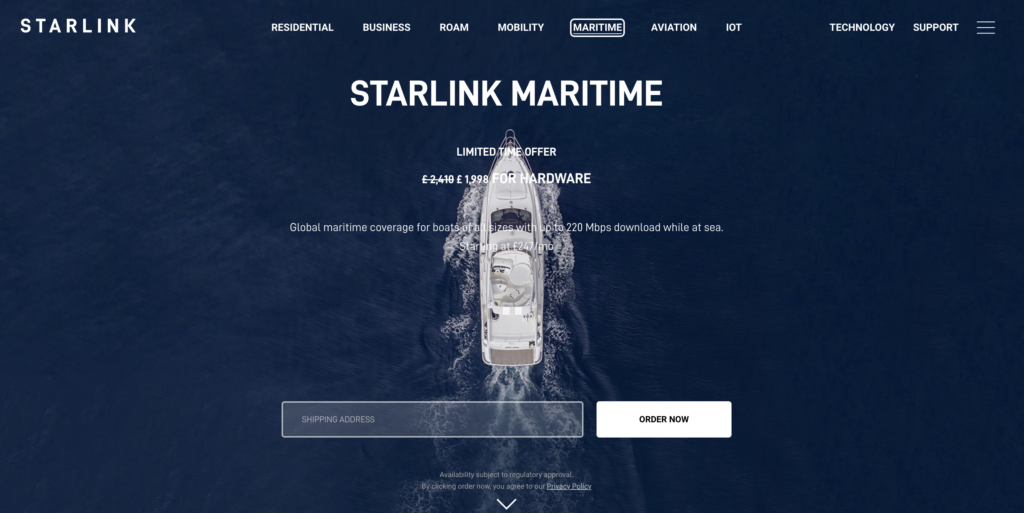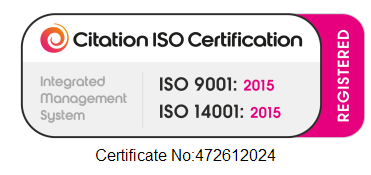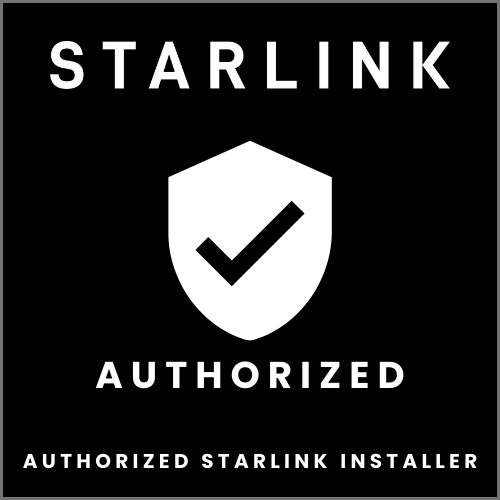One of the UK’s first AUTHORIZED STARLINK™ INSTALLERS.

Before Starlink created its constellation of broadband satellites, internet connectivity at sea was impossible. Even the most luxurious yachts needed to have the basic necessity of an internet connection.
All across the globe, reliable and high-speed internet is available for maritime professionals and sailors, thanks to Starlink Maritime, which SpaceX built to keep ships, boats, and other modes of water transportation connected while at sea.
This complete guide to Starlink Maritime will cover the technology behind the satellite system and the benefits for maritime industries and sailors hitting the water for leisure purposes before looking into how much it costs to keep connected via Starlink, the hardware requirements, the installation process, and the considerations you will need to make before choosing the best package. This impartial guide will also highlight potential connectivity issues, including weak signal strength and incompatibility with existing systems installed onboard.
In 2019, the space-based satellite internet service Starlink was launched by its parent company, SpaceX, to provide global high-speed and reliable internet access.
>> How does Starlink connect to the internet?
SpaceX started launching thousands of satellites into Low Earth Orbit (LEO) to make this possible. At the last count, Starlink has 4,000 small satellites in LEO. The positioning of the satellites, which are far closer to Earth than traditional satellites in geostationary orbits, enables faster internet speeds and reduced latency.
Starlink initially launched to provide high-speed internet to underserved and rural areas, where services were limited or nonexistent. Never one to do things by halves, Elon Musk expanded the scope of his project to serve other applications and industries; Starlink Maritime is a significant part of this project expansion.
In 2023, Starlink Maritime now offers broadband speeds similar to those available in European and American coastal areas. Under normal conditions, users of the service can stream, browse, and communicate with people on the mainland while enjoying download speeds of up to 350 Mbps; upload speeds can vary between 5 and 20 Mbps.
As impressive and pioneering as Starlink Maritime may be, as with any innovative service, there are still teething issues and flaws. A big part of the Starlink Maritime catch is the cost; after paying a high upfront installation fee, there is a sizeable monthly fee to stay connected to the satellite network; the more affordable options come with stringent data caps and slower speeds.
Connectivity can also be tricky to maintain for moving boats; when the position of a vessel shifts, the signal can weaken or disconnect, as the Starlink satellites need precise positioning to maintain high-speed connectivity. Furthermore, installing satellite, cellular and Wi-Fi systems on boats can create challenges.
With its ever-expanding network of LEO satellites, the current limitations of Starlink Maritime won’t endure forever. Significant changes are already well underway, and it is only a matter of time before the service is practically limitless.
Book your Starlink Installation today
Professional Starlink installation team across the UK.
When it comes to alternative solutions, there are other satellite communication companies, including Iridium Certus, FleetBroadband, and Marine VSAT systems; however, they tend to come with a higher price tag and slower internet speeds. On the other hand, traditional maritime internet solutions can provide more connection.
To stay connected at sea via Starlink, you will need:
The Starlink Maritime hardware costs £2,410; it carries the same price tag as Starlink Business Hardware.
If you want 220 Mbps download speeds, standard global maritime coverage will cost £970 per month.
A priority service is also available, at a hefty monthly sum of £4,846. The priority service includes top network priority and faster speeds. However, a 30-day trial period, remote monitoring, and 1–2-week delivery come as standard.
Starlink hardware can withstand a certain degree of exposure to moisture. However, it is still vital for boat owners to limit excessive exposure to water and regularly check for corrosion or other wear and tear damage. The satellite dish must also be routinely cleaned to remove salt, dirt, and other debris.
Boat owners are also advised to install software updates as soon as possible to ensure optimal performance. By taking a preventative and proactive approach to hardware and software maintenance, the system will remain efficient, reliable, and safe.
Even though broadband speeds may be slower, and connectivity may be a little more temperamental than Starlink implies in its promotional material, Starlink Maritime is still a vital service for boat owners and those in the maritime industry.
While it is essential to consider the potential limitations of the service before weighing up if the installation and monthly fees are worth the cost, it cannot be denied that Starlink is enhancing interconnectivity by enabling people to work remotely at sea and improving the quality of life at sea in general.

Let's get you online!
Fill in your details and we'll be in touch shortly.

Please fill in your details
Head Office:
11 Old Steine, Brighton, BN1 1EJ

© 2025 All Rights Reserved.